So What’s the Kite Bike Like, Then?
So what’s the kite bike like, then?
By Ben Klaasen
(Read the original post at Anemoi kiting blog.)
It turns out that I haven’t actually written much about riding the PTW Cougar 2.5 kite bike on this blog, so this post should remedy that! It’s a long one, so skim the boring bits.
OK; a bit of history. I’ve been riding kite buggies for more than ten years, first on a Peter Lynn folding (using Jojo race kites, what was I thinking) and then later on a Libre V-Max flying much tamer Ozone kites. I enjoy a cruising style of buggying; racing bores me (all that business of getting ordered around and jostling for position, it’s too much like work) and I don’t have the balls for freestyle.
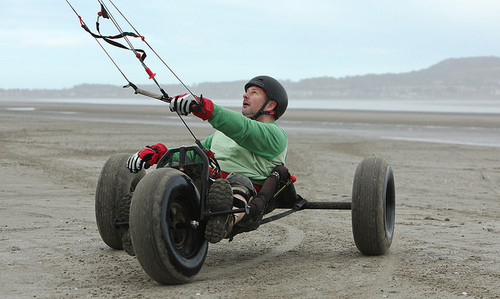
Back in 2009 I gave up buggying and sold all my kit, including my beloved white van, sick and tired of the backbiting kiting scene in Dublin at the time. I told myself I didn’t miss kiting.
Early last year, my good friend John (who I’d originally gotten to know in that same scene years before) lured me back to kiting when he bought himself a Flexifoil bug and dug out some of his old Ozone Samurai kites. I got the hunger for kiting again; let’s face it, nothing beats the gorgeous feeling of throwing a buggy around the beach.
I was in the market again for kit. I got the idea into my head of asking the world-famous (and famously modest) Popeye The Welder (also known as Carlos Fandango) to build me a kite bike after I saw a picture of some pretty cool bikes running on bigfoots on Carl’s website. This was in February 2011. I messaged Carl via the racekites.com PM system:
Hi Carlos –
I’m Ben, used to frequent racekites.com loads a few years ago. I gave up kiting for a while but now I’m getting the urge again, and was thinking of getting a kite bike. I’ve always been really impressed by the custom buggies you’ve built, so I reckon you’re the guy to quiz first. Can you tell me if it’s possible to buy kite-bike backends for Lynn or Libre buggies? If not, would you consider doing a custom job?
regards Ben
Pops got back to me the following day with a reply:
Hi Ben, I dont think you can buy an off the shelf back end, but certainly yes I could make you one…
I would need sizes and dimensions and preferably some kind of drawing
Regards Carl
We exchanged contact details and a few days later chatted for forty-odd minutes on Skype. Carl told me he’d never built a kite bike before, but reckoned that he could find a solution. He recommended starting with a Cougar 2.5 kite buggy base and working from there to build a bike modification which would allow me to switch between bike and trike modes. By the end of the conversation the commission was agreed. The delivery date would be early May and the build would start after Carl got back from NABX 2011. I even drew a picture:
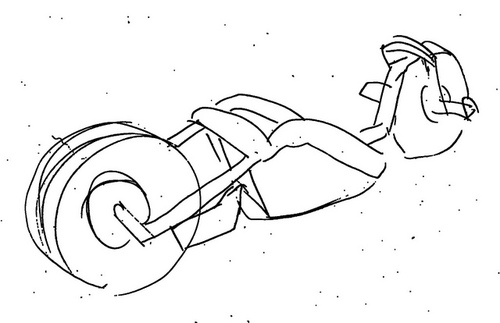
…but I don’t think it was quite the kind of drawing that Carl needed.
The rest of our communication over the course of the project was by email. I sent a deposit and Carl was on the case straightaway, sending me a tantalizing picture of the rear forks:
The rear end or kite bike attachment…well yes I have been giving it a lot of thought, I made some drawings, sent them to be cadded up, sent to the laser cutters, received them back and made them up….see, I am working lol
I have gone for the simplest idea I could think of…basically, you will un bolt your axle and bolt the kite bike attachments in their place, there are attachment holes to move the rear axle forwards or backwards to suit
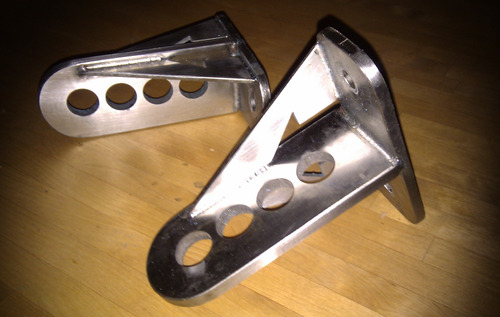
I was delighted that Carl had found a solution to how to mount a single back axle on the bike and keep the frame from flexing as well. (…and see the arrow detailing on the mounts? Superb.) Photos of the back axle, side rails, front forks and back rest appeared before Carl headed off to NABX 2011 at Ivanpah.
(I wasn’t jealous at all. Not a bit.) After Carl got back, The regular photo updates showed the rest of the bike coming together until finally it was completed, by the beginning of May, as Carl had promised.
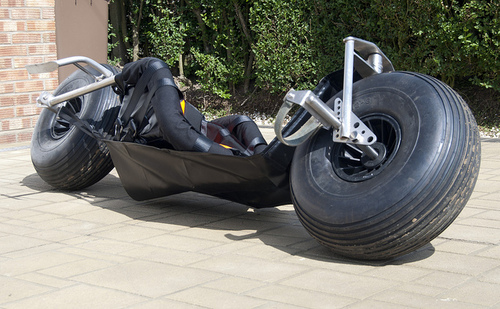
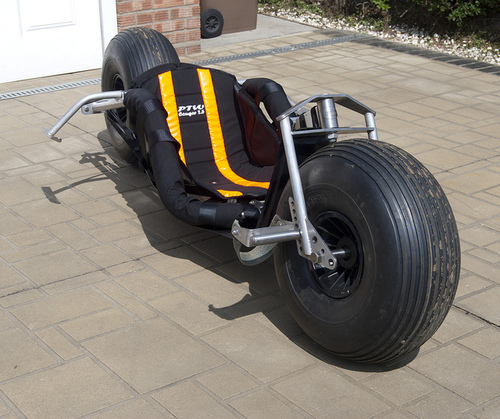
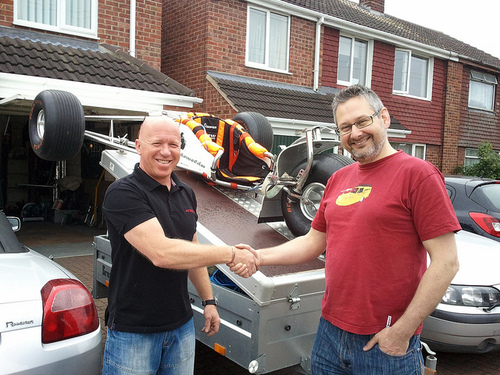
It was early June before Mrs. Ben and myself could head to the UK to collect the bike. The drive from Holyhead through the Peak District to the beautiful town of Lincoln was a pleasure. Finally we pulled up outside Pops’ place – I was bursting with excitement – not only was I about to take delivery of a custom-built PTW bug, but I was going to meet the man himself (…and his chatty and welcoming wife, Mrs. Fandango – thanks to you both for your hospitality!)
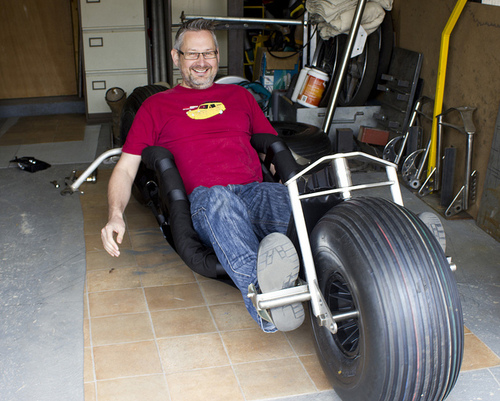
Out in the PTW garage workshop, Carl had the buggy set up in bike mode:
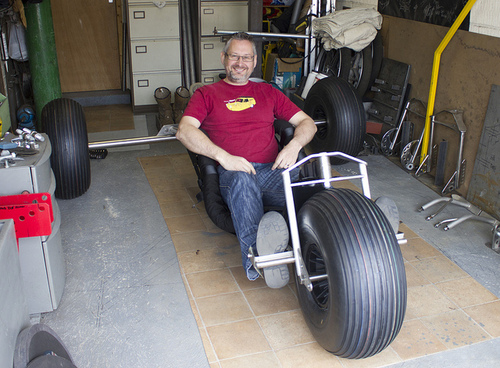
…and then with a flash of spanners, converted it to trike mode:
All I had to do was climb in and grin like an idiot whose Christmases have all come at once. The bug was amazingly comfortable, solid and rigid. I felt totally safe nestled in the seat (designed and assembled by Jon and Helen, the wizard team at buggybags.co.uk) and snug between the side rails, which Carl had custom-built for my frame. The finish on the stainless steel buggy was immaculate and the welding work superbly clean. All in all, British engineering at its finest. It felt like a functional bike – but the proof of that would be in test rides to come; Carl hadn’t tried out the bike himself!
We spent the rest of the afternoon with Mr and Mrs. Fandango, heading into Lincoln for a late lunch at a funky coffeeshop together, chatting away about kiting adventures and Carl’s experience at NABX. We figured out a way to pack the disassembled bug into the back of my saloon:
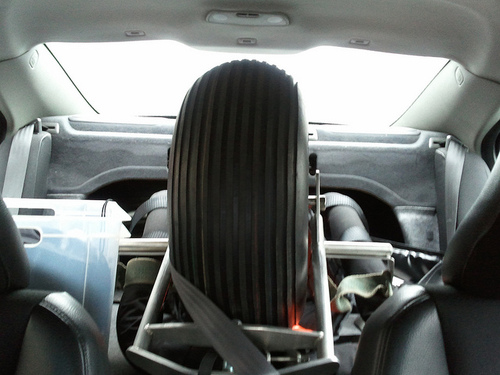
…and made our farewells to Carl and Mrs. Fandango. After another day or two in Lincoln, Mrs. Ben and I headed back to the windy shores of Ireland.
So how was I feeling about the prospect of riding a kite bike? I stil had no idea if I’d even be able to pick it up, or how easy or hard it would be to master. Frankly, I was a little anxious at the prospect, but I’d made the choice to make the purchase, so I was committed! I was glad that Carl had suggested that the bike should also work as a complete Cougar 2.5 buggy as well – if the whole experiment went horribly pear-shaped, I’d still have a monster bug in a well-established PTW design on the traditional trike layout.
The following evening, I brought the bike to Phoenix Park, Dublin, just a short distance from where I live, assembled the bike at the bottom of a small hill and started practicing getting the feel of the bike by downhilling in it, without a kite. I discovered the bike balances automatically when travelling above a certain (surprisingly slow) minimum speed, in the same way a pushbike does. The trick to turning is not to turn the front wheel with your feet, just to look where you want to go, lean a bit in that direction and let instinct take over. I discovered that adjusting the seat for a higher riding positon made controlling the bike easier; I have no idea why that is. Maybe the sensation of tilt is easier to feel and correct?
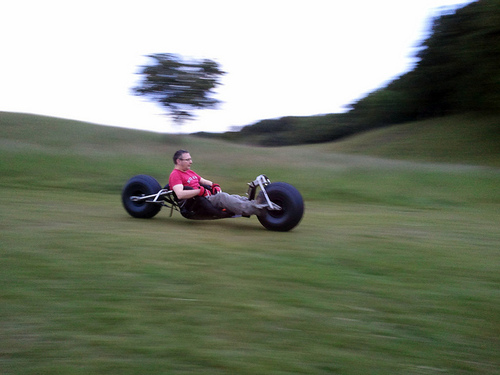
Here’s a short clip of me getting the hang of balancing the bike on another shallow hill nearby, taken the following evening:
I was itching to get out and try the bike with a kite, so a couple of weeks later on a Friday evening, my regular kiting buddy John (the other contributor to the Anemoi blog) and I headed off to Achill Island, in the wilds of County Mayo on Ireland’s windswept West coast.
We were dead lucky with the tides and weather conditions; the wind was strong and smooth, blowing a perfect onshore at about twenty knots onto Keel beach, which is a long, wide expanse of hard-packed sand – and this being summer in Ireland, it’s too cold and windswept to be populated by anyone but hardy walkers and a handful of Mayo children with antifreeze in their veins. Did I mention Ireland is perfect for kiting, practically all year round?
John and I set up our gear and John ripped up the beach, tricking unhooked in his Flexi buggy – read about his experience of the Achill weekend.
The wind was strong enough that my kite of choice was a first-generation two square metre Samurai kite – it’s a rock-solid and predictable kite that’s very forgiving – a design classic.
It didn’t take me long to get up on two wheels, thanks to some tips from Kitezone Muriwai, the Kiwi kite biker (thanks, man), who’d told me to start off lined up for a beam reach (perpendicular to the wind) with the bike resting on the skid on the upwind side. To get up and going, he told me, you swoop the kite for a burst of power, steer a little towards the kite to get fast enough to get into auto-balance mode, then angle away to put more tension on the lines and accellerate further.
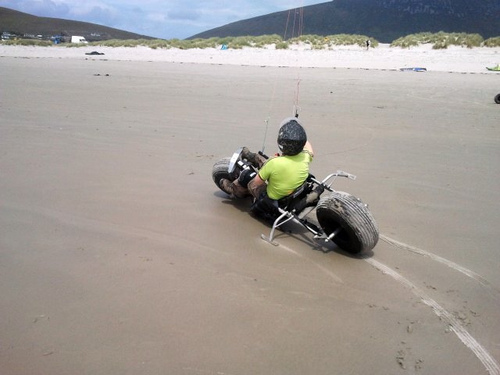
Getting moving, staying moving and making small course adjustments in a more-or-less straight line was comparatively easy; turning took me a few hours to begin to get the hang of. At first, I took long, swooping, barely controlled turns, but later in the day I got much tighter turns sorted – most of the time. There are really only two ways that a turn can go wrong – I’d either lean too hard into the turn and drop a skid on the sand, which felt ungainly but doesn’t actually affect the turn, or else I’d go too wide and end up in the rocks under the dunes. None of that mattered; I was having a brilliant time learning how to ride the bike; at no point in the proceedings did I feel frustrated or defeated. The excellent weather conditions and location certainly helped.
Another thing I noticed pretty quickly is that on a bike you don’t have the option of a power-slide to scrub off speed, as you do on a trike (at least not while learning) – the only option is to ride into the wind and let the kite slow you down.
John had the presence of mind to shoot some video on his phone; here I am, grinning from ear to ear, riding the bike on Keel beach:
There’s more of that, but it needs to be deshakered (like this clip) and assembled into a short vid. (Don’t hold your breath.)
Back in Dublin over the following weeks, I took the bike out a couple of times on Dollymount (Dublin’s main kiting spot, right in Dublin bay), once quite successfully and uneventfully; the next time, conditions were much gustier, and I managed to injure my knee quite badly getting flipped in the bike by my new Ozone Method 4m – my foot stayed trapped in the footpeg and my knee joint went *goink*. I had a limp for two weeks and it took the knee at least a couple of months to heal fully so that I could flex my leg completely without pain. The buggy was undamaged, apart from the e-Trex holder, which was bent a bit when the bike flipped over.
Since then I’ve avoided using the bike on Dolly; the beach is narrow, much more heavily populated by pedestrians and kiters and seldom receives smooth onshore winds. I reckon I’ll be more comfortable practicing riding the bike on bigger, wilder beaches out West before taking the bike out more regularly on Dolly.
So, all in all, am I happy with my purchase? Undoubtedly yes. I get out in the bug whenever I can, either in trike mode or in bike mode. I don’t have a van anymore (I’m skint at the moment, but I’m looking at vans online anyway) so I have to assemble and disassemble the bug every time, but that’s less of a hassle than I expected; I’ve developed a routine and I can now build the bug reasonably quickly:
The design of the bike is very good; there are a few small snags which have only become apparent as I’ve ridden the bug and bike in a variety of conditions: the skids are positioned just behind my elbow, so I have to remember to lift my arms when turning the kite hard. I remove them in trike mode. Running fast over moguls, my feet can get kicked out of the straps and right off the peg – it’s not a nice feeling to see your feet dancing in the air in front of you in a blur with the buggy being steered by Heisenberg’s uncertainty principle. Perhaps longer heel straps would solve that; if the ball of my foot is on the peg, I could press myself into the bug riding over rough terrain. A toe loop of some sort might work too.
The positives far outweigh the gripes; PTW bugs are supremely comfortable, beautifully designed and built. Without fail, the Cougar turns heads on the beach among kiters and non-kiters alike. The machine is perfect for my riding style; I like a big, wide comfortable ride, which is exactly what the Cougar is; a touring bike of buggies. I get to cruise as fast as I want, I can throw the bug into satisfying, sand-spraying slides and I can say hello to the seals basking at the far end of the beach, across the soft sand, where no-one else ever goes. Kiter heaven.
Reply by popeyethewelder
Hi Ben, great write up. I was very surprised though to read about your problems with the heel straps….I have not heard of this problem from anyone else, either in my buggies or anyone else’s…..so I am wondering whats happening here. You said your feet are bouncing around on the peg, again, this I have not heard of before, years ago, I used you have pegs with no straps, and over a rippled beach my feet used to slide down the pegs seen here
Heal straps completely stopped the foot sliding down the peg, it was now impossible. Even from the early days, we were always told to put pressure on the foot pegs, to brace against the back rest onto the foot pegs, this became apparent when you see race buggies flying in the air see these videos
These guys are not strapped in, but purely bracing against the footpegs, in fact those buggies do not even have a back rest, they are just using the seat to brace against……so like I said, I was very concerned about the problem you are having, I can only assume, your foot is barely touching the peg and just resting on the strap??? longer straps, as you suggest wont alter anything there, but please try.
What most people do is this….a lot of buggies are built with round pegs…..there is a reason for this, and the reason is pilots set the straps long enough just to get the heel of their boot under the peg….offering some security, but be aware of making it too good a fit. You can also do the same with your foot plates, use the bottom of the plate to hook your heel under.
With even slight amount of pressure then on the pegs, it becomes impossible for your feet to float above your pegs…..how frightening.
I was also sorry to hear about the accident with your foot getting caught resulting in a sore ankle for a few weeks…..again I have heard of this maybe once possible twice in all the time I have been kiting…..but never with heel straps, so I would like to hear what has happened here, when years ago pilots had straps above the foot, your accident was far more likely to happen, because as you are getting lifted or flipped, the foot would or could get caught in the strap……heel straps, again eliminated this problem, so I would like a more detailed account of what happened there….
I am not saying for one moment you are doing anything wrong, I am just trying to get to the bottom of what is happening so I can maybe alter something to avoid this problem on future builds.
Reply by Ben Klaasen
Right, Carl, after looking at those vids, it’s definitely my technique! Those guys are jaw-droppingly good. I can’t believe they’re not strapped in. I was going by the notion that a light touch on the pegs is all that’s needed to keep control – after all, you don’t grip the handlebars on a bike like you’re hanging on for dear life. Then again, it depends on how hard you’re pushing it – I guess mountain bikers have a firmer grip than a tourer on an asphalt road. Nobody ever told me to brace in a bug, so that’s a worthwhile tip!
I can see in the vid of you on on Mablethorpe that you’re constantly adjusting your foot’s position on the peg – and at 4:06, it nearly gets whacked right off the peg when the front wheel hits a mogul.
I’m able to tuck my heel under the peg as you describe – it feels a bit funny, so I tend not to lock it in like that, but you’re saying that’s exactly what I need to be doing! I’d expected the peg to be like a bicycle pedal – you put the ball of your foot on the pedal, not the arch. Obviously if I’m bracing properly, a longer strap won’t make any difference, like you say. I’ll try it next time I’m on the beach. I’ll talk to some of the kite bikers to find out what sort of bracing technique they use.
I can’t quite remember what happened when I got yanked out of the bike that time – basically I had the kite to my right, just trundling slowly on a beam reach, the wind gusted and tore me out of the bike sideways. The bike flipped over and somehow my foot stayed in the peg. I felt the knee go as I was ejected. Bit of a bummer, but you live and learn. I never even brought it to the doc, it just swelled up a bit and then healed perfectly after a few months.
cheers Ben
